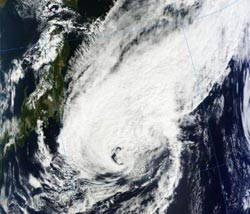NASA sees extra-large, now extra-tropical storm Prapiroon fading

The MODIS instrument aboard NASA's Terra satellite captured this visible image of Extra-tropical Storm Prapiroon on Oct. 19 at 01:15 UTC (Oct. 18, 9:15 p.m. EDT), about 270 nautical miles southeast of Tokyo, Japan and moving away.<br><br>Credit: NASA Goddard MODIS Rapid Response<br>
The Moderate Resolution Imaging Spectroradiometer (MODIS) instrument aboard NASA's Terra satellite captured a visible image of Extra-tropical Storm Prapiroon on Oct. 19 at 01:15 UTC (Oct. 18, 9:15 p.m. EDT).
The storm appeared on the MODIS image to be as large as the main island of Japan and the strongest thunderstorms and heaviest rainfall appeared north of the center of circulation over the open waters of the western North Pacific Ocean.
At 0300 UTC on Oct. 19 (11 p.m. EDT on Oct. 18), Prapiroon's maximum sustained winds were near 45 knots (51.7 mph/81.3 kph). It was centered about 270 nautical miles (310.7 miles/500 km) southeast of Tokyo, Japan, near 31.9 North latitude and 142.6 East longitude. It was moving away from Japan and headed east-northeast at 27 knots (31 mph/50 kph).
On Oct. 19, Prapiroon marked its twelfth day of life. It was born as Tropical Depression 22W on Oct. 7. On Monday, Oct. 8, the twenty-second tropical cyclone had organized and strengthened into Tropical storm Prapiroon and later became a typhoon. Now, as an extra-tropical cyclone, Prapiroon is expected to fade over the next couple of days over open waters.
Media Contact
More Information:
http://www.nasa.govAll latest news from the category: Earth Sciences
Earth Sciences (also referred to as Geosciences), which deals with basic issues surrounding our planet, plays a vital role in the area of energy and raw materials supply.
Earth Sciences comprises subjects such as geology, geography, geological informatics, paleontology, mineralogy, petrography, crystallography, geophysics, geodesy, glaciology, cartography, photogrammetry, meteorology and seismology, early-warning systems, earthquake research and polar research.
Newest articles

Superradiant atoms could push the boundaries of how precisely time can be measured
Superradiant atoms can help us measure time more precisely than ever. In a new study, researchers from the University of Copenhagen present a new method for measuring the time interval,…

Ion thermoelectric conversion devices for near room temperature
The electrode sheet of the thermoelectric device consists of ionic hydrogel, which is sandwiched between the electrodes to form, and the Prussian blue on the electrode undergoes a redox reaction…

Zap Energy achieves 37-million-degree temperatures in a compact device
New publication reports record electron temperatures for a small-scale, sheared-flow-stabilized Z-pinch fusion device. In the nine decades since humans first produced fusion reactions, only a few fusion technologies have demonstrated…





















